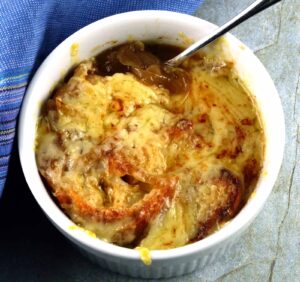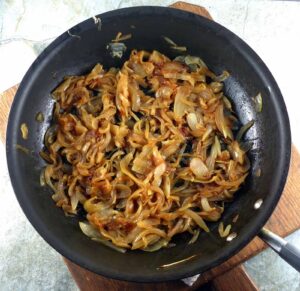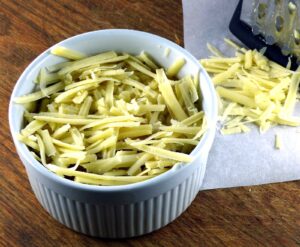With its crown of delicious melting Gruyère cheese atop a savory broth enriched with sweet caramelized onions, onion soup is one of the most iconic dishes in the repertoire of French cuisine. Relying primarily on inexpensive onions and stale bread, versions of onion soup have long been served as common peasant food in France.
The version of cheesy onion soup that we know and love today became popular in the 19th century in the restaurants around Paris’s central wholesale food market, Les Halles. The restaurants of the quartier served soupe l’oignon gratinée as a hearty breakfast to the market workers in the early morning hours. Late-night revelers enjoyed it as well and appreciated the dish for its reputed hangover-curing properties. The renowned food market moved to Rungis, on the outskirts of Paris, in 1973. But fortunately, the onion soup tradition lives on in the Les Halles neighborhood at restaurants, such as Le Pied de Cochon, which is open around the clock.
Onion soup is typically enjoyed in restaurants, but it is actually quite simple to make at home. Here are a few tips to ensure a great onion soup:
- Caramelizing onions takes patience, but my technique of cooking the onions covered for most of the time allows them to cook evenly and relatively quickly.
- Good broth is the foundation of a soup like this. Beef broth is classic, and of course, homemade is the best. (See the instructions for making broth at the end of the recipe.) While I don’t think packaged or canned broth is worthwhile for this recipe, I have found that frozen bone broth, which can be found at grocery stores like City Market, is fine—but expensive.
- Be sure to use genuine Gruyère or Comté cheese, which has a nutty flavor and good melting properties. And don’t skimp on the cheese; allow about ½ cup shredded cheese per serving.
While you dream of enjoying authentic onion soup in a Parisian bistro, why not warm up a chilly Vermont evening with a steaming bowl at home!
Ingredients
1 tablespoon butter
1 tablespoon neutral vegetable oil, such as avocado, grapeseed, or canola
5 cups sliced yellow onions (about 3 medium-large)
¼ teaspoon kosher salt, plus more to taste, if desired
4 cups beef broth, preferably homemade (recipes follow), or frozen beef bone broth, thawed
1 teaspoon red wine vinegar
Freshly ground black pepper to taste
16 slices baguette (1/2-inch thick)
1 clove garlic, halved (optional)
2 cups shredded Gruyère or Comté cheese
Preparation
1. Heat the butter and oil in a large nonstick skillet over medium-high heat. When the butter has melted, add the onions and salt. Cook, stirring or tossing with tongs occasionally, for 5 minutes. Reduce heat to medium, cover the pan, and cook, stirring or tossing occasionally, until the onions are softened and light golden, 10 to 15 minutes. (Adjust the heat as necessary if the onions are caramelizing too quickly.) Remove the lid, reduce the heat to medium-low, and cook, stirring or tossing often, until the onions are golden and have reduced in volume, about 5 minutes.
2. Transfer the onions to a large saucepan. Add the broth and bring to a simmer over medium-high heat. Adjust the heat to maintain a simmer, and cook, partially covered, until the flavors have blended, about 20 minutes. Season with vinegar, salt, and pepper to taste. (The soup can be prepared ahead to this point. Cool, then cover and refrigerate for up to 3 days. Reheat before continuing.)
3. Preheat the broiler. Line a baking sheet with foil. Arrange the baguette slices on the baking sheet, and toast under the broiler until crisp and light golden, 40 to 60 seconds per side. If desired, rub the cut side of the garlic clove over the baguette toasts.
4. Place four broiler-safe onion soup bowls or 16-ounce ramekins (individual soufflé dishes) on the prepared baking sheet. Ladle hot soup into the bowls until they are about two-thirds full. Divide the toasts among the bowls, and break them, if necessary, so they fit into the bowls in more or less a single layer. Ladle additional soup into each bowl. Make sure the toasts are completely submerged. Sprinkle ½ cup cheese evenly over each bowl.
5. Broil the soups until the cheese has melted and is starting to turn golden, about 2 minutes. Serve immediately.
Serves 4.
Tip: If you do not have broiler-safe bowls, sprinkle the cheese over the baguette toasts and broil them until the cheese has melted. Float the cheese toasts on top of each soup.
Homemade broth: When I want to have beef broth on hand, I often make a pot au feu (basically boiled beef, but pot au feu sounds much more appealing). When the beef is cooked conventionally on the stovetop, it can take several hours to become tender and for the broth to develop favor, but an Instant Pot reduces the cooking time dramatically. The meat, which I enjoy warm and in salads and sandwiches, becomes tender and succulent. The broth—the most valuable part—is full-bodied and satisfying.
To make Instant Pot pot au feu: Put a 1½-to-2-pound brisket (trimmed) in an Instant Pot or a stovetop pressure cooker. Add aromatic vegetables: an onion (peeled and halved), the white and pale green parts of a cleaned leek, a peeled carrot, a celery stalk, a half-dozen peeled garlic cloves, and 1 tablespoon tomato paste. Season with 1 teaspoon dried thyme (or several branches fresh thyme), several sprigs fresh parsley (optional), a bay leaf, 1 teaspoon kosher salt, and ½ teaspoon whole black peppercorns. Pour in 4 cups water, lock the lid in place, and cook at high pressure for 50 minutes. Let the pressure release naturally for 20 minutes. Then release the remaining pressure manually. Using tongs and a slotted spoon, transfer the brisket to a cutting board. Let the brisket rest for at least 10 minutes before slicing. Strain the broth through a fine sieve into a large bowl, discarding the solids. If you’re not using it right away, chill the broth quickly over an ice bath, then refrigerate. Once the broth has chilled, you can skim off the solidified fat. (The broth will keep, covered, in the refrigerator for up to 4 days or in the freezer for up to 6 months.)
To make traditional beef broth: Roast 2 to 3 pounds beef bones in a roasting pan or on a baking sheet in a 400°F oven until browned, about 30 minutes. Stir the bones, then add an onion (peeled and halved), a peeled carrot, and a celery stalk. Continue to roast until the vegetables are browned, 15 to 20 minutes longer. Transfer the vegetables and bones to a stock pot. Cover with 2 to 2 ½ quarts water. Add a half-dozen peeled garlic cloves, 1 tablespoon tomato paste, 1 teaspoon dried thyme (or several branches fresh thyme), several sprigs fresh parsley (optional), a bay leaf, 1 teaspoon kosher salt, and ½ teaspoon whole black peppercorns. Bring to a simmer. Skim off the foam. Cook, partially covered, for 4 to 5 hours, adjusting theheat to maintain a gentle simmer. Add water if the level falls below the level of the bones. Strain the broth through a fine sieve, discarding the solids. If not you’re not using it right away, chill the broth quickly over an ice bath, then refrigerate. Once the broth has chilled, you can skim off the solidified fat. (The broth will keep, covered, in the refrigerator for up to 4 days or in the freezer for up to 6 months.)
Patsy Jamieson




